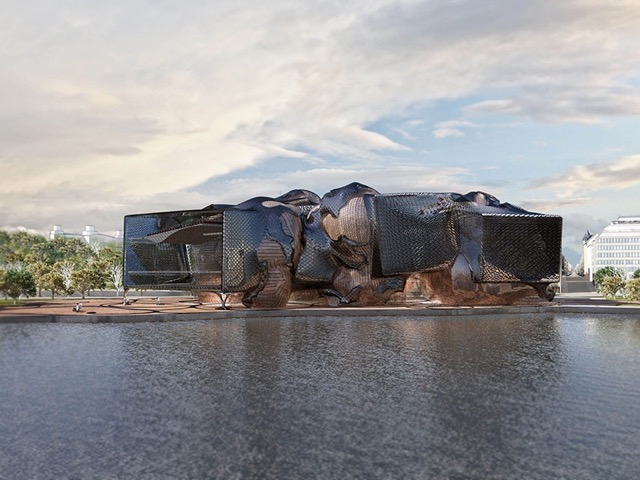
Are open design contests still an effective tool to recruit diverse architectural talent?
By Aaron Tannenbaum
[dropcap]T[/dropcap]hroughout her storied career in art and architecture, Maya Lin has distinguished herself as one of Yale College and Yale School of Architecture’s most accomplished alumni. Lin achieved international renown for her talents at the ripe age of 21 when her design for the Vietnam War Memorial was selected over 1,441 others in a blind competition. The anonymity of this contest enabled Lin to break down barriers of age, sex, and race and thrust the art of a young Asian-American woman, despite considerable backlash, into a global spotlight. Unfortunately for young designers in search of their big break, Lin’s story is a unique success in the realm of open architectural contests.

Nowadays, such competitions typically result in thousands of hours of unpaid labor, hundreds of unworkable (at best) submissions, and a design culture focused on internet virality rather than originality. While contests succeed in gathering work from a diverse range of experienced and neophyte, establishment and fringe, local and international architects and giving them each a shot at success, many winning designs never come to fruition. Too often, architects invest themselves in high profile design contests only for their entries to be lost in a sea of renderings, each sleeker, glossier, and more aggressively eye-popping than the last.
In an article for FastCo.Design, Kriston Capps points to the contest that the Solomon R. Guggenheim Foundation held to design its new museum in Helsinki. The competition collected work from a staggeringly wide array of entrants: the 1,715 entries came from firms and individuals in 77 different countries. The quality of submissions, however, is not quite as impressive as the breadth of their creators. “Plates of spaghetti, floating eyeballs, piles of string cheese—the designs don’t inspire a lot of confidence,” writes Capps dismissively. A source of this issue is that computer-assisted design technologies become cheaper and more user-friendly every year, enabling contest entrants to produce unconventional, futuristic, and infeasible renderings in a desperate struggle to differentiate themselves from competitors. Such mock-ups that win design competitions often do so for their shock value rather than their ingenuity.
It’s not just the architects who produce excessively flashy contest entries who are responsible for this trend — it’s the clients who insist on hosting these competitions in the first place. While there are many valid reasons why a client may want to select an architect through an open contest, there is a certain air of likeability that comes along with hosting one. We think everyone deserves a shot, hosting an open contest says. The Guggenheim’s Helsinki competition is a telling example: its website reads that the open nature of the contest “reflect[s] the Guggenheim’s… belief that outstanding original design can speak across cultures.” While this competition has found the Guggenheim a winning museum design, it has also contributed to the Foundation’s liberal, forward-thinking brand.

That enticing but impractical designs often go unbuilt should come as no surprise. What’s less expected, however, is the internet fame that these renderings enjoy in architectural and mainstream social media circles. Floating around niche websites such as Dezeen and Citylab and more popular platforms such as Facebook and Twitter, glossy contest-winning designs rack up thousands of likes and retweets that contribute, regardless of their feasibility, to their architects’ brands and reputations. Some, including architecture critic Alexandra Lange, worry that contemporary architects exploit social media to talk about themselves and their brand when they should be talking about their work and the work of their colleagues. “Social media can do more for architecture and design than showcase pretty faces,” Lange wrote on Dezeen.com. Open design competitions that are conducive to shiny but hollow mock-ups only serve to exacerbate this trend. The increasing popularity of these contests combines with social media where self-promotion is the norm to create a perfect storm: a flood of superficially impressive renderings diluting architectural discourse.
What can be done to improve this state of affairs? A start would be for architecture and design oriented social media users to be more mindful of the content that they post. Many people don’t realize that sharing eye-catching designs can contribute to a culture of architectural planning geared more towards going viral than being actualized. Further, clients in need of an architect’s services should more strongly consider awarding commissions through more traditional processes before resorting to open contests (even though the request-for-qualifications process is far less enticing than an international brand-boosting competition). Encouraging architects to jump through exaggerated hoops to distinguish themselves from hundreds of competitors inevitably leads to a mindset in which feasibility is secondary to flashiness.
Of course, we must not forget that open contests have been instrumental in giving voice and opportunity to emerging, marginalized architects. Though many are rightfully wary of competitions for the culture of superficiality that they create, we do not want to ditch the format altogether and hamper the emergence of the next Maya Lin.
Aaron Tannenbaum ’19 is a freshman in Jonathan Edwards College. Contact him at aaron.tannenbaum@yale.edu.